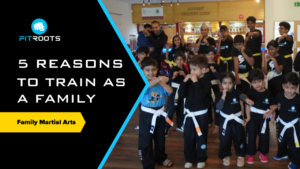A common question that many ask is, which Martial Art is better than the rest?
In this blog you will learn a bit about how Karate and Kickboxing compare in; self-defence, complexity, history, strength & conditioning and finally popularity.
Their similarities include that they are both:
• From Japan
• Stand-up Martial Arts styles (hand-to-hand combat between opponents in a standing position)
• Based on punches and kicks
Their similarities result from their close relationship historically and practically.
However, despite their similarities, they are two very different Martial Arts.
Self-Defence – Round 1
Just like any Martial Arts question the answer here is, it depends… It depends on the style, the school and the student.
Some styles will help you build more obvious self-defence skills, others will teach you more about awareness.
Self-defence isn’t only about fighting and blocking, the best form of self-defence is to end the fight before it has started.
Let’s see how Karate and Kickboxing compare here:
Karate For Self-Defence
More popular styles taught in the West include Goju-ryu, Shotokan-ryu, Wado-ryu, and Shito-ryu.
Karate in this sense is heavily focused on practicing ‘forms’ or ‘Katas’.
Kata’s/Forms
These refer to a detailed choreographed pattern of movements which can be practiced alone, or within groups and in unison.
When taught correctly, Katas are an effective training tool to develop perfect form, speed, and accuracy.
You will need to learn how to adapt these skills in order to fight and defend yourself in a real-life situation.
Kumite
Which is Karate’s form of sparring literally means ‘grappling hands’. In Gohon Kumite, which beginners practice in traditional Shotokan karate the defender steps back each time, blocking the attacks and performing a counterattack after the last block.
There are some harder styles of Karate which are more suitable than others for self-defence, a few of these include Kyokushin and Kenpo Karate.
Kyokushin
Kyokushin is a stand-up, full contact Karate style. Kyokushin means ‘Ultimate Truth’, and is deeply rooted in a philosophy of self-improvement, discipline, and hard training. The aim of Kyokushin is to teach students to overcome their physical limitations, to find their own ‘truth’.
Kenpo
Kenpo means ‘Fist Law’. It is a style of Karate that is often defined by its more ‘hands-on’, flowing approach which is similar to Kickboxing. The style focuses on linear strikes and kicks, pressure point manipulation, and circular movement, as well as joint locking and breaking.
While Kyokushin and Kenpo are some of the more effective styles of Karate, it is worth mentioning that they are not the most popular, or commonly taught in the West.
Karate is not a fighting tool for beginners.
It will take a good Karate student around 6-10 years to defend themselves effectively.
Kickboxing For Self-Defence
You must learn how to take hits and how to get hit. It is so important in self-defence. Kickboxers train to hit, get hit, and hit back. They train realistically against manoeuvring opponents who use feints and dummies (deceptive/pretend attacks), and they learn how to hit and defend in a variety of combinations.
Sparring
Kickboxing’s best tool for learning self-defence is sparring. You will learn how to execute everything you have learnt against an opponent in a controlled environment. This is not just about the physical techniques, but also the mental teachings that come with Martial Arts too.
In sparring you will learn how to build your focus, taking note of your opponents every move, so you can respond accordingly. You will learn how to spot a real threat from a fake one, and most importantly, you will learn how to keep calm under pressure.
Sparring is a sure-fire way to build your stamina, strength, and endurance. It is often the fighter with higher endurance that keeps on going until the end, and ultimately wins.
Defence
Similar to Boxing, Kickboxers know how to hold a tight guard, which can be hard for even the most trained fighters to get through. A well-trained Kickboxer will also know how to block a kick, and counter all at the same time.
This brings me to highlight that in a real-life situation, defending is just as important as attacking, because once you get knocked out, it’s ‘Game Over’.
Verdict…
Kickboxing Comes Out On Top For Self-Defence
Taking into consideration the most popular styles taught, Kickboxing comes out on top for self-defence.
That’s not to say you cannot pick up great self-defence skills at a Karate School. Just find the right style and a good instructor.
However, the fluidity that comes with Kickboxing will train you to focus on attacks, blocks, and counters. This Martial Art will get you comfortable with taking hits, which is arguably more a mental thing.
Remember, the first time you get hit in a fight (especially if you aren’t ready or used to it), you might retreat, and this will not work in your favour. When this comes to fighting for your life, this could very easily be the end if you aren’t ready.
To answer this question fully, you would also have to address a core weakness of both these stand-up Martial Arts…
What happens when the fight goes to the ground?
In a street fight, this is the last place you want to be, but styles like Wrestling, Jujitsu, and Brazilian Jiu Jitsu come in handy in these situations.
Ultimately, the best form of self-defence comes from practicing multiple forms of Martial Arts, and taking the best of them all to suit your style.
In a street fight, you never know who your attacker is going to be. They might be taller, stronger, heavier, or more cunning than you.
So, whatever your means of self-defence, outmanoeuvre and outsmart your attacker, and remember there are no rules on the street.
Awareness is your greatest tool in any fight.
Complexity – Round 2
Complexity Of Karate
Karate students train to truly perfect their technique, quite often this takes a lot of time and patience too.
As you progress higher up the ranks towards Black Belt, you will find a whole new set of practical techniques.
You will learn a variety of throws and locks from other Martial Arts such as Jujutsu (another Japanese Martial Art). This is when some of the more effective training happens.
You may not be exposed to this variety as a beginner. The techniques you are exposed to will depend on the Martial Arts School. Some schools focus on mastering a few techniques, others teach a broader range of techniques.
You will generally start by training at long-range distances, for example, the Step Forward Front Punch, to both the body and head. At this level, this style relies on the assumption that your opponent will back away in a backward, and linear fashion.
Complexity Of Kickboxing
Kickboxing will very quickly teach you how to fight, and if you train hard, you will quickly learn how to fight well.
Kickboxing is primarily made up of four punches and two kicks.
These include; Jab, Cross, Hooks, Uppercuts, Front Kick and Roundhouse (Knees and Elbows are less common).
That’s not to say there aren’t other techniques, but these are the main ones. And you will generally learn variations of these techniques in a variety of combinations, mixing in elements of defensive techniques too.
This makes Kickboxing a great choice if you want to quickly learn a Martial Art.
Especially for those who aren’t too convinced on the long-term commitment that Karate requires.
While Kickboxing is more limited than Karate in its variety of techniques, it sets you up with a strong foundation with effective transferrable skills.
Fluidity, timing, awareness, and countering will prove invaluable for any Kickboxing student wanting to pick up Karate.
Verdict…
Karate Is Best For Complexity
This is a close one.
Even though Kickboxing has a better grasp of the different ranges for beginners. It often relies on the student to keep developing, using their own creativity to continue mastering the art.
Karate has strong, straight, single strikes, but lacks continuity and fluidity in sparring. As a result, it gets labelled – ‘static’ or ‘rigid’. In many street fights, you’ll often find that there are a variety of round punches thrown, not just long linear punches that you will more commonly find in Karate.
For me, Karate just about tips the scales for the best complexity. But this is only as you progress to Black Belt and start learning techniques from other Martial Arts.
It is a Martial Art that requires an adaptable student, who knows how to differentiate techniques for training, and those for real-life application.
Just like with any Martial Art, it is down to the student to adapt the techniques to suit their style and flow. Style can be trained, but it is best to find your own style, and this comes down to a variety of factors including your size, weight, movement patterns etc.
What’s best for you – Karate or Kickboxing?
It’s worth mentioning the level of complexity will depend on what you are looking for, and what suits your learning style.
If you want to pick up the basics quickly, Kickboxing is probably your best bet.
It’s limited range of techniques can be learnt in a relatively short amount of time. However, learning the different variations and application will take you longer.
If you take up Kickboxing, you will learn to fight straight away.
While you will not be able to master Kickboxing in a 12-week course, you will surely become more proficient in Kickboxing than Karate, in a shorter amount of time. This is mainly down to the many forms and katas that come with learning the foundations of Karate.
History – Round 3
History of Karate
Very little is known about the exact origins of Karate.
It is a Martial Art developed in the Ryukyu Kingdom. It developed from Kung Fu and changed from the name 唐手 (‘Chinese hand’) to 空手 (‘empty hand’).
Karate began as a common fighting system known as ‘te’. It is understood that Karate evolved over several centuries. It begun when it became illegal to carry weapons, but people still feared for their safety.
Just like other Asian Martial Arts, Karate became a part of the Japanese culture and rituals. It influenced the people of Japan in many ways, it became a tool for students to develop discipline, focus, mental strength, and physical health.
The systemisation of Karate happened in Japan. As a result, the Karate Gi became the uniform, and is still very common in Karate schools all over the world.
Many instructors of Karate refuse to update the art, wanting to preserve its tradition. This has resulted in very little developments of the art since inception.
These instructors ignore the fact that the traditional Karate taught today, was formed for a society that functioned very differently.
History Of Kickboxing
Kickboxing is a Japanese hybrid Martial Art based on kicking and punching. It was developed by adapting techniques used in Karate, Western Boxing, and Muay Thai.
It originated in the late 1950s in Japan, and grew in popularity in the West over the next 10 years.
By the mid 1960s the first true Kickboxing events were being held in Osaka.
Kickboxing is said to have evolved from Thailand’s Martial Art form Muay Thai.
– Yamada Tatsuo, who established “Nihon Kempo Karate-do”, was interested in Muay Thai because he wanted to perform Karate matches with full-contact rules, since Karate sometimes had more limiting rule sets.
– Some years later, a Japanese boxing expert Osamu Noguchi came across the art of Muay Thai. He always wanted to develop a kind of fighting technique that had the soul of Karate, but allowed full striking. After studying Muay Thai, he merged it with the full contact techniques of Karate and Boxing, which eventually became what we know today as Kickboxing.
When Kickboxing started emerging as a sport in the U.S. in the 1970s, fighters had to learn through a trial and error process. Most fighters came from Karate backgrounds, and fighting full contact bouts highlighted certain shortcomings.
With its evolution Kickboxers started to use the fighting, training, and conditioning of professional Western Boxing. They increased the number of rounds for sparring before a round. They took up full contact sparring, and took a lot of punches to their body, including their head.
This strengthened both their body and mind to endure virtually any kind of challenge in the ring.
Kickboxing became more powerful as the students grew fitter and stronger.
And thus, the dynamic modern version of Kickboxing emerged into an action-packed discipline. It soon reached the international sport circuit, and then started expanding across the globe.
Verdict…
Karate is Number One For History
Of course, with its extensive history and emphasis on culture, Karate has an easy win here.
Not to mention, many know that Karate influenced the development of Kickboxing.
That’s not to say that Karate comes without problems. Students of Karate, BEWARE, failing to adapt your style to modern times may work against you.
Traditional Karate may have been practical in Japan years ago, but does it prove physically practical in modern times?
As Bruce Lee said, “You must be shapeless, formless, like water. When you pour water in a cup, it becomes the cup. When you pour water in a bottle, it becomes the bottle. When you pour water in a teapot, it becomes the teapot. Water can drip and it can crash. Become like water my friend.”
Strength and Conditioning – Round 4
Karate For Strength And Conditioning
In sport Karate, sparring (kumite), and in training, attacks are more similar to point sparring in Kickboxing. This means that any time a punch or kick is landed, the attacker gets a point, and the match is reset. This attack usually focuses on speed and precision rather than power, due to the nature of the point scoring.
Karate students also train in katas. Due to their nature, no contact conditioning of the body takes places as the techniques are performed in the air. This will not condition your shins, elbows, or knees as you will find in Kickboxing.
Katas can be used both for physical and mental training.
When you’re practicing a traditional kata either alone or in a group, you will feel the synergy as your training becomes a tool for meditation. The spiritual side of Karate will depend on the school, but they are a great meditation and mental strengthening tool.
Kickboxing For Strength And Conditioning
The amount of energy required for high level Kickboxing is enormous.
Kickboxers often spend time conditioning their shins and various other body parts in preparation for a fight. A fighter without conditioning will struggle once they receive a clean shot.
Even a student practicing Kickboxing for leisure, will find that padwork drills and sparring will condition their body over time.
Many who practice traditional Martial Arts will find that after a Kickboxing session they are not as fit as they might believe. Their punches and kicks will not be effective enough, and they also struggled to stay in the ring to fight 10 rounds.
This is partly because in traditional Martial Arts, students are taught to pull back their kicks and punches, as contact sparring using gloves was extremely rare.
Verdict…
Kickboxing Trumps Karate For Strength and Conditioning
Kickboxing’s contact drills and sparring will condition your shins, knees, elbows, arms… This contact training will have you conditioning the parts of your body you are creating an impact with.
That being said, if you are at a ‘fitness’ Kickboxing class, don’t count on building any strength or conditioning. Those classes are there to help you burn calories, and are more like aerobics than Kickboxing.
Karate and Kickboxing students, if you are only training in the Dojo, it’s not enough to build strength.
The likelihood is that you will be training at most, three times a week, and this is not enough if you want to build your strength and conditioning.
To build good foundational and functional strength, incorporate Functional Training into your training routine.
Ensure you are training both sides of your body, and don’t fall into the trap of training your ‘better’ side. That’s not how our body has been built to function.
Popularity – Round 5
Popularity Of Karate
The 70’s saw a spike in Karate’s popularity in the West. Bruce Lee, Chuck Norris, and several other stars brought Martial Arts to Hollywood. Karate and other Martial Arts became the centre stage for 1970s action scenes, boosting its popularity and wow factor.
By the 80s Karate’s popularity spiked with the release of The Karate Kid in 1984. With the film’s success, Karate schools on every corner started filling up with film fanatics.
The popularity Karate had in the 70s and 80s led to Dojos popping up on every street. Then in 2010 Jaden Smith’s The Karate Kid led to another spike in the popularity of Karate. Proving that popular culture plays a big part in the Martial Arts industry.
It became very easy for anyone who knew a few Karate moves to open up their own Dojo, and to start charging students to teach them.
This led to the ‘McDojo’ epidemic of today. When you end up in a McDojo, which is a school which aims to take your money in exchange for promoting you to Black Belt, you end up ‘mastering’ your Martial Art without actually learning anything.
For more on how to spot a McDojo – Read our 5 Signs Of A Bad Martial Arts School blog here.
Popularity Of Kickboxing
Many say that Kickboxing just doesn’t get the exposure that some of the other modern Martial Arts such as Boxing or MMA get.
However, in Japan and in the Netherlands, Kickboxing is really popular.
In a competitive sense, Kickboxing is better known, and many Kickboxers take their skills and go to fight in the UFC, and other MMA organisations.
The standardisation of Kickboxing as a competitive sport, leaves less room for interpretation of correct form than in Karate. This helps Kickboxers find common ground, and can make it simpler to find the right school.
Verdict…
With the future of Martial Arts being considered… Kickboxing comes on top for popularity.
This is not solely based on the number of Kickboxing students/schools vs Karate. It is more about where the Martial Art is going moving forwards.
Strictly speaking, where nuber of students are considered, Karate seems to have more students and schools than many other Martial Arts
Karate is still seen more of an activity that children do, and quickly grow out of as they approach their teens. More adults take up Kickboxing as a hobby, and we are now seeing more parents signing up their children without fear that their child will get knocked out in class.
But what about other more popular Martial Arts?
Styles such as MMA and BJJ have really taken off over the past few years.
Which has made me wonder why Kickboxing hasn’t taken off in the same way as MMA especially considering its modern-day adaptation.
My guess is that the high energy, fast paced brutality of MMA keeps viewers eyes fixed to the screen, without being able to look away. Just like the old fashion gladiator fights.
With MMA has truly taking off in a relatively short amount of time, it shows that with evolution, Martial Arts will not disappear.
MMA fighters are even getting paid to feature in films now too.
Which raises the question… Is Karate getting pushed to the side in favour of more modern Martial Arts?
Martial Arts is not the only industry which has seen the recent push back of Traditional vs New.
Look at the music industry, the book industry, fashion, dating… The list really goes on.
Modern day living looks for convenient, fast, and effective. All of that, and we want it cheap too! But really what it means is disposable, because when things are disposable, it is easier and quicker to get something new and shiny.
Karate Vs Kickboxing – The Final Verdict
Kickboxing came out on top for me but that’s based on what I look for.
Maybe based on the points above, you decide Karate comes out on top.
Because, that’s the way Martial Arts goes right? Always dividing opinions…
If you are unsure and have both a Kickboxing and a Karate School that you’re interested in, try them both out.
Most schools have a free trial offer, and if you need longer to try it out just ask. You won’t be pledging allegiance when you sign a membership agreement, that’s for when you reach Black Belt…
Seriously, just like anything, if it’s not a good fit for you, leave. One of the worst students to have is a disengaged one.
Some advice for you if you are looking to join a Karate School:
Some Karate Schools will focus on self-defence, others on the visual ‘arts’ side. Whether or not they portray their school accurately, if you like the sound of what they do, try it out to see which one works best for you.
Most importantly, what do you enjoy and what can you see yourself doing in the future? Martial Arts when practiced correctly is. Lifelong endeavour.
If you have to choose, choose the one you connect with and enjoy the most.
Even when you choose which Martial Art is right for you, then you need to choose the school. This is where it can get even harder because as the old saying goes, they all agree on one thing, and that’s to disagree.
Some advice for you if you are looking to join a Kickboxing School:
While many have deemed Kickboxing more of a ‘sport’ than a Martial Art, it is down to the student to interpret their Martial Art.
Try to find somewhere that will teach you both the physical and mental aspects of Martial Arts. Many Kickboxing schools will focus more on the physical technique and bypass the mental teachings of Martial Arts as a whole.
These teachings are so important in teaching us how to apply Martial Arts as a way of life and not just a sport.
Get in touch for more advice on whether you should choose Karate or Kickboxing.
P.S. If you are in Slough and would like to drop by to see if Kickboxing is for you, Book your free taster class today >> Click Here To Register <<








